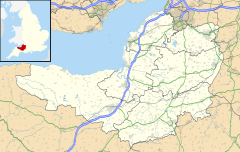Huntworth
| Huntworth | |
|---|---|
 Huntworth Bridge over the Bridgwater and Taunton Canal |
|
| Huntworth shown within Somerset | |
| OS grid reference | ST315345 |
| District | |
| Shire county | |
| Region | |
| Country | England |
| Sovereign state | United Kingdom |
| Post town | BRIDGWATER |
| Postcode district | TA5, TA6, TA7 |
| Dialling code | 01278 |
| Police | Avon and Somerset |
| Fire | Devon and Somerset |
| Ambulance | South Western |
| EU Parliament | South West England |
| UK Parliament | |
Huntworth is a small hamlet and farming community (population approximately 50), within the civil parish of North Petherton 1 mile (1.6 km) east of the M5 motorway 3 miles (4.8 km) from Bridgwater, Somerset, England.
When the Bridgwater and Taunton Canal was opened in 1827 it joined the River Parrett by a lock at Huntworth, where a basin was constructed, but in 1841 the canal was extended to a floating harbour in Bridgwater, and the Huntworth link was filled in. The canal and river were not re-connected at this point when the canal was restored, because the Parrett is by then a salt water river laden with silt, whereas the canal contains fresh water. Not only is there a risk of silt entering the canal, but the salt water cannot be allowed to contaminate the fresh, as the canal is still used for the transport of drinking water for Bridgwater's population.
The Imperial Wireless Chain, also known as the Empire Wireless Chain, was a strategic international wireless telegraphy communications network, created to link the countries of the British Empire.
Between 1929 and 1940 Huntworth was the site of the "Bridgwater" Beam Wireless Station, which received HF communications from Drummondville and Yamachiche in Canada, and Kliphevel (now Klipheuwel) and Milnerton in South Africa, working with an associated transmitter station at Bodmin.
Each aerial for the Beam Wireless Station stretched to nearly half a mile (0.78 km) long, and consisted of a row of five 277 feet (84 m) high lattice masts, erected in a line at 640-foot (200 m) intervals and at right angles to the overseas receiving station. These were topped by cross-arm measuring 10 feet high by 90 feet wide (3m x 27.4m), from which the vertical wires of the aerial were hung, forming a 'curtain antenna'.
...
Wikipedia

